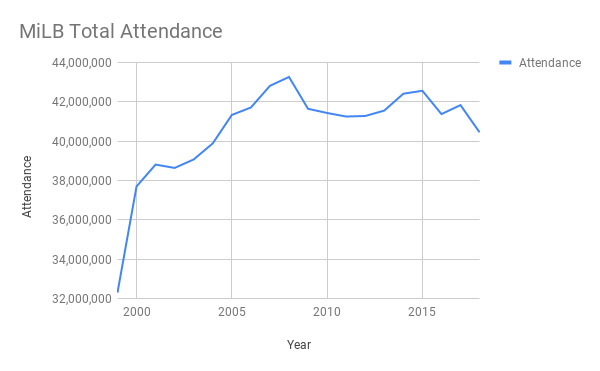Minor League Attendance Numbers Take A Big Dip


Image credit: A detailed view of the outfield wall at Arm & Hammer Park before the 2018 Eastern League All Star Game. (Photo by Mark Brown/Getty Images)
Minor League Baseball announced Wednesday that 40,450,337 fans attended minor league games during the 2018 season, a drop of 1,382,027 fans compared to last season.
MiLB was understandably quick to point out some explanations for why attendance fell. It was unusually cold this April, with 73 games that started with a game-time temperature below 40 degrees. There were zero games in April 2017 where the game-time temperature was below 40.
On top of that, there were also fewer games played. After a request by Major League Baseball, the Triple-A leagues and Double-A Eastern League cut their number of scheduled games from 142 to 140. Those lost dates can explain roughly 400,000 of the attendance drop.

Those facts are undeniably true, but dig a little deeper and weather and lost dates doesn’t fully explain the 2018 attendance report. The total attendance for 2018 was the worst overall mark in 14 seasons. The average per-game attendance of 3,922 fans is also the worst of the past 14 seasons.
Minor League Baseball President Pat O’Conner said everyone will study the numbers and look for avenues for improvement, but he is not particularly worried by what MiLB views as an anomaly.
“There is no real grave concern going into the winter,” O’Conner said. “We need to figure out what happened to us. The things we can deal with, we need to deal with.”
The 2018 attendance report appears to be another reminder that after years of explosive growth, Minor League Baseball’s attendance seems to have found it’s high-water mark and has leveled off. Attendance is still far beyond the much more modest numbers teams drew for the vast majority of the nearly 150 years of minor league baseball. Staying flat or generating modest growth compared to the previous year’s attendance is a more realistic goal nowadays.
At the end of the 20th century into the start of the 21st century, Minor League Baseball attendance was a perpetual growth machine. In 1998 (the first year that Triple-A expanded to its current 30 teams), 32.3 million fans attended minor league games. Just two seasons later, 37.7 million fans came through the games. By 2008, 43.26 million fans came to minor league games.
There were a number of factors that helped lead to the attendance boom. A building boom in the mid and late 1990s saw many cities replace old and outdated stadiums with much-improved facilities that helped attract new fans. Teams modernized their front offices with an improved focus on promotions, in-game entertainment and group sales, and they began to attract many first-time fans and convinced them to come back again and again.

But that steady growth has largely plateaued over the past decade and now has dropped off. The 2008 all-time record seems far away—teams drew nearly 250 more fans per game per team that year than they did last year.
And it goes beyond a cold April or fewer home dates. April’s average attendance numbers were easily worse than average attendance in any of the past five seasons, which can be explained at least in part by the cold weather. But May, June and July’s average attendance numbers were also worse than in those months in any of the previous five seasons. The August and September 2018 average attendance marks each trailed four of the past five seasons.
Of the 160 minor league teams in the U.S. and Canada, 105 (65 percent) had a lower average attendance in 2018 than 2017.
The rest of Minor League Baseball’s measures are more positive than the attendance numbers. Merchandise sales are up. Gross revenues are up. O’Conner noted that teams are seeing fans spend more money when they come to the ballpark, even if there aren’t more fans coming through the gates.
“Is success an increase in gross revenues?” O’Conner said. “We’ve increased our gross revenues over the last 20 years, an average of 5.5 percent (per year).
“When attendance is at least flat and financials go up, you are looking at an increase in per-cap (per capita spending per attendee) because of the math. There are a lot of things about this business that make me optimistic.”

Comments are closed.